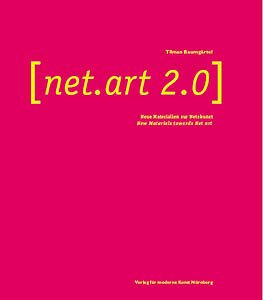Tilman Baumgärtel: net.art 2.0. Neue Materialien zur Netzkunst / New Materials on Art on the Internet (2001) [German/English]
Filed under book | Tags: · art criticism, art history, internet, internet art, interview, net art, technology

“This follow-up to the first net art book documents developments in net art at the turn of the millenium. A large portion of the book consists of interviews with artists such as Julia Scher, Peter Halley, Blank & Jeron, Jodi, etoy and Lisa Jevbratt, who have created major projects using the internet. The conversations are supplemented by a documentary appendix and an essay by Tilman Baumgärtel describing the specifics of net art and its place in artistic discourse. Interspersed with the text components are images of more than 130 net-based works.”
Translated by David Hudson
Publisher Verlag für moderne Kunst, Nürnberg, 2001
ISBN 3933096669, 9783933096661
263 pages
Review: Lutz Nitsche (MedienWissenschaft, 2002, DE).
Author (archived)
Publisher (archived)
WorldCat
PDF (15 MB)
Comment (0)Megan Driscoll: Art on the Internet and the Digital Public Sphere, 1994-2003 (2018)
Filed under book | Tags: · art history, internet, internet art, net art, networks, public sphere, web
“This dissertation narrates the development of internet art, a diverse set of practices united by their interrogation of the technological, social, and/or political bases of computer networks. Covering the period from 1994, when internet art coalesced around the rise of the World Wide Web, to 2003, when both internet art and internet culture writ large began to respond to the rise of social media and web 2.0 technologies, the dissertation homes in on specific net art projects that variously engaged or challenged this period’s most persistent claim: that the internet is a new, digital public sphere. By studying how these artworks critiqued this claim, the dissertation uncovers three major models through which net art has asserted the publicness of computer networks—as an interpersonal network that connects or unites strangers into groups; as a virtual space akin to physical spaces of public gathering, discourse, and visibility; and as a unique platform for public speech, a new mass media potentially accessible to all.
Claims for the public status of computer networks rest on their ability to circulate information and facilitate discussion and debate. This definition of publicness is rooted in the concept of the classical public sphere as theorized by J�rgen Habermas. The dissertation thus reviews Habermas’s model of the classical public sphere, and its most significant critiques, in order to interrogate the terms of a digital public sphere. The dissertation also engages Michael Warner’s work on the formation of publics, counterpublics, and the mass-cultural public sphere; Oskar Negt and Alexander Kluge’s analysis of shared experience as the foundation of the formation of public spheres and the role of mass media in this process; Henri Lefebvre’s articulation of the social production of space; and Gilles Deleuze and Alexander Galloway’s respective analyses of the role of network logics in systems of control.
As a whole, the dissertation provides an historical account and critical analysis of internet art that encompasses not only its technological evolution but also its confrontation with the claims of publicness upon which our understanding of computer networks, and the art made on and about them, are founded.”
PhD Dissertation
Publisher University of California, Los Angeles, 2018
349 pages
via Cornelia
Annet Dekker: Collecting and Conserving Net Art: Moving beyond Conventional Methods (2018)
Filed under book | Tags: · archive, archiving, art documentation, conservation, document, internet art, net art, networks, preservation, software, software art, web

“Collecting and Conserving Net Art explores the qualities and characteristics of net art and its influence on conservation practices. By addressing and answering some of the challenges facing net art and providing an exploration of its intersection with conservation, the book casts a new light on net art, conservation, curating and museum studies.
Viewing net art as a process rather than as a fixed object, the book considers how this is influenced by and executed through other systems and users. Arguing that these processes and networks are imbued with ambiguity, the book suggests that this is strategically used to create suspense, obfuscate existing systems and disrupt power structures. The rapid obsolescence of hardware and software, the existence of many net artworks within restricted platforms and the fact that artworks often act as assemblages that change or mutate, make net art a challenging case for conservation. Taking the performative and interpretive roles conservators play into account, the book demonstrates how practitioners can make more informed decisions when responding to, critically analyzing or working with net art, particularly software-based processes.
Collecting and Conserving Net Art is intended for researchers, academics and postgraduate students, especially those engaged in the study of museum studies, conservation and heritage studies, curatorial studies, digital art and art history. The book should also be interesting to professionals who are involved in the conservation and curation of digital arts, performance, media and software.”
Publisher Routledge, 2018
ISBN 9780815382416, 0815382413
x+192 pages

